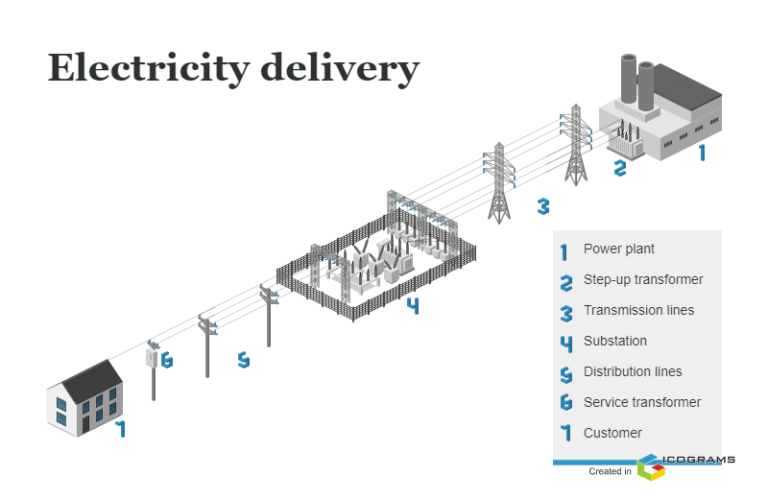- IELTS WRITING TASK 1 - PROCESS DIAGRAM
Electricity Delivery
You should spend about 20 minutes on this task.
Task: The diagram below illustrates the process of electricity delivery from a power plant to consumers. Summarize the information by selecting and reporting the main features, and make comparisons where relevant.
Write at least 150 words.

Image Source | icograms.com
Sample Answer, C1 English Level, Advanced, Band Score 6.5-7.5
Electricity delivery starts at a power plant, where various energy sources like coal, natural gas, or renewable sources are used to generate electricity. This electricity is then sent to a step-up transformer, which increases its voltage. Higher voltage is preferred for long-distance transmission as it reduces energy loss. The electricity is then transferred through transmission lines, which are high-tension cables that carry the power over great distances.
To manage the voltage for safe distribution, the electricity arrives at a substation. At the substation, the voltage is reduced through transformers before moving to distribution lines. Distribution lines are the medium-voltage lines that carry electricity throughout neighborhoods and communities. As the electricity approaches individual homes and businesses, it passes through a service transformer. This transformer further lowers the voltage to a level that is safe for everyday use.
Finally, the electricity reaches the customer, powering homes, offices, and industries. This interconnected system ensures a reliable supply of electricity, allowing us to enjoy lighting, appliances, and technology. From the power plant to your socket, each step in the electricity delivery process is crucial in ensuring the safe and efficient distribution of this essential energy source.
Electricity delivery involves a series of steps to bring power from a power plant to our homes and businesses. It all begins at the power plant, where electricity is generated. This electricity is in a low voltage form, which is not suitable for long-distance transportation. To make it suitable for transmission, a step-up transformer is used. This device increases the voltage, reducing energy loss during transmission.
The high-voltage electricity then travels through transmission lines, which are large cables that can span long distances. However, this high voltage is still not suitable for direct use, so the electricity arrives at a substation. At the substation, the voltage is lowered
through another transformer, making it safe for further distribution.
From the substation, the electricity is carried through distribution lines, which are smaller cables, to neighborhoods and homes. Finally, near each house, a service transformer further reduces the voltage to a level that can be safely used by appliances. This is the electricity that customers rely on to power their lights, devices, and appliances.
The intricate process of electricity delivery serves as a conduit, channeling power from its origin in power plants to our residences. Initially, electricity is birthed within power plants. To facilitate its efficient transmission across expansive distances, a step-up transformer elevates its voltage. Subsequently, this amplified-voltage electricity courses through transmission lines, resilient cables extending over considerable expanses. However, this heightened-voltage form of electricity remains unsuitable for direct utilization.
Hence, at a substation, a secondary transformer mitigates the voltage, rendering it apt for dissemination. This modified electricity then traverses distribution lines, more modest cables that ferry it into localities. In close proximity to homes, a service transformer enacts further voltage reduction, ensuring compatibility with our gadgets. Ultimately, this culminates in the provision of low-voltage electricity, which consumers harness to power their residences.
In summation, the journey of electricity entails pivotal junctures: its inception, voltage manipulation via transformers, transmission, voltage attenuation, distribution, culminating in its conveyance to homes. This meticulous progression guarantees the dependable arrival of electricity, illuminating and empowering our daily routines.

